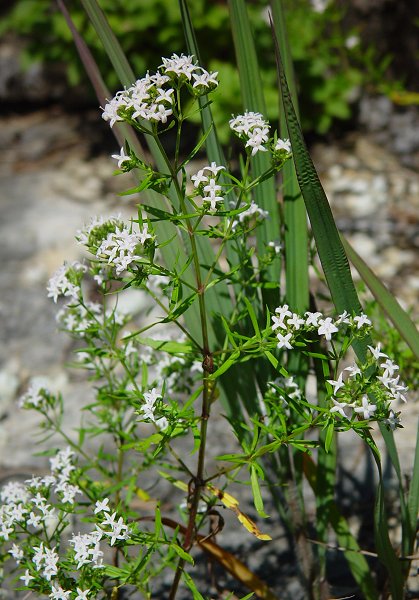Houstonia nigricans (Lam.) Fernald
Narrow-Leaved Bluets

Native
CC = 5
CW = 5
MOC = 62
© DETenaglia
Houstonia nigricans (Lam.) FernaldNarrow-Leaved Bluets | |
 |
Native CC = 5 CW = 5 MOC = 62 |
© DETenaglia |
|
Family - Rubiaceae Habit - Perennial forb, sometimes woody at the base, the rootstock usually woody and branched.
Stems - Weakly ascending to erect, to 40 cm, multiple from base, dichotomously branching, glabrous or minutely roughened.
Leaves - Opposite, sessile, usually also produced in dense fascicles from some of the main leaf axils. Plants lacking basal rosettes at flowering. Stipules 1.0-3.5 mm long, triangular, sharply pointed or with 2-3 slender lobes at the tip, somewhat uneven along the margins. Leaf blades 7-40 mm long, 0.5-4.5 mm wide, linear to very narrowly elliptic or very narrowly lanceolate, sharply pointed at the tip, narrowly angled or tapered at the base, the margins entire, but roughened with minute, stiff hairs, rolled under, the upper surface sparsely roughened or minutely hairy, the undersurface sparsely roughened or sparsely to moderately and minutely hairy, the venation with only the midvein observable or rarely with a faint pair of lateral veins.
Inflorescences - Terminal and axillary, usually dense clusters of 3-9, these sometimes appearing as small, flat-topped to dome-shaped panicles. Flowers sessile or on stalks to 3 mm long. Inflorescence divisions subtended by a pair of foliaceous bracts.
Flowers - Flowers distylous. Calyx lobes 1-2 mm long, sometimes slightly unequal, less than 1/2 as long as the adjacent corolla tube, narrowly triangular to ovate. Corollas funnelform, white to pink or pale purple, lacking a ring of contrasting color in the throat, externally glabrous, internally pubescent in most of the tube, the tube 3-5 mm long, the lobes 2.5-4.0 mm long, triangular.
Fruits - Capsules 3-4 mm long, 1-2 mm wide, subglobose to more commonly obovoid or oblong-ellipsoid, not or only slightly flattened, partially inferior, rounded to slightly notched at the tip, glabrous or sparsely roughened. Seeds 0.5-1.0 mm long.
Flowering - May - October. Habitat - Glades, bluffs, upland prairies, loess hill prairies, forest openings, streambanks, pastures, fields, fencerows, railroads, and roadsides. Origin - Native to the U.S. Lookalikes - H. longifolia. Other info. - This plant can be found in the Ozark section of the state north to a few eastern counties that border the Missouri river. It is absent from most of the northern part of the state but reappears in a few northwest counties where the loess hills are found. Beyond Missouri its natural range begins on the west in Arizona, and extends in a broad swath across the southern U.S., up into New England and the upper Midwest, and into Canada. It is recognized by its narrow, opposite leaves and small, 4-petaled white flowers. It is very similar in appearance to the closely related H. longifolia, and differentiation of the two can be difficult. Look for woody lower stems, absence of basal rosettes at flowering, fringed stipules, and short or absent flower stalks. Photographs taken in the Ozark Scenic Riverways, Shannon County, MO., 6-21-03 and 6-28-03, and in Shannon County, MO., 6-17-05 (DETenaglia); also at Little Lost Creek Conservation Area, Warren County, MO, 7-24-2016, and at Victoria Glade, Jefferson County, MO, 8-19-2020 (SRTurner). |